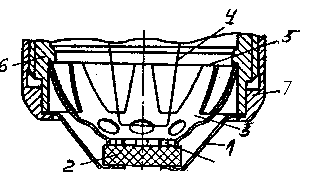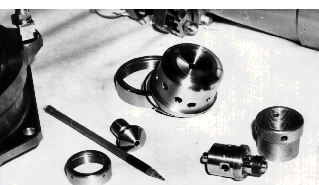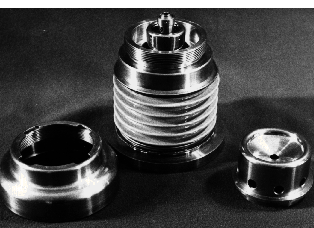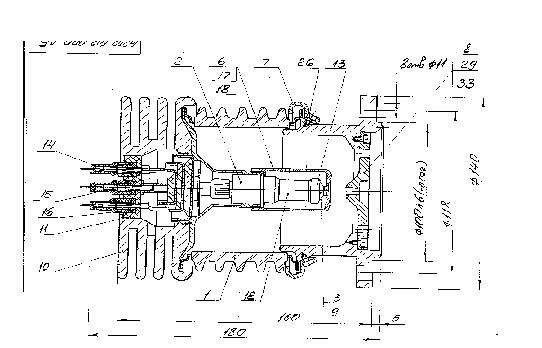The design and main parameters of electron beam sources
for accelerators are described. Two designs of cathode assemblies
for RF electron injectors were developed. For increasing lifetime
of the sources lanthanum hexaboride single crystal emitters are
used. Indirect heated disc cathodes with diameter 4-6 mm and thickness
1,5 mm ensure beam current up to 10 A and small surface erosion
rate under ion bombardment. The latter parameter is 3-4 times
smaller than for lanthanum hexaboride polycrystal emitters. The
described electron sources will be used for compact linear accelerators.
For linear accelerators which are used in applied
fields it is especially important reliability and stability performance
of all systems incorporated, including injector. A number of electron
sources designs are used in compact electron linacs.The most critical
element of the injector is the emitter, which in considerable
degree defines the performance characteristics of the whole beam
generating system. As a rule,thermionic cathodes emitters are
used in applied electron linacs. Wire emitters are simple,but
they have low operation time and stability, considerable beam
emittance.Disc and bar cathodes require more complicated assembly
design,but ensure high stability and electron brightness,large
operation period without taking apart.Good beam formation is also
very important in many fields. The most exact beam parameter describing
transverse beam dynamics is beam brightness at gun output. It
was shown in [1, 2] using analysis of beams parameters at the
output of many linacs, that
one of the most important factors defining the transverse formation
quality is a beam brightness at the injector output, which normalized
value is maximum in the injector and decreases during the beam
acceleration. Taking into consideration these conclusions it is
very important for high output linac beam brightness to obtain
minimal value of transverse emittance in the electron source,which
is defined by many factors including stability of emission characteristics,
cathode position,etc.The purpose of this work was to develope
the designs of electron sources for compact electron linacs of
3 and 10 GHz range with improved performance characteristics of
the output beam. As they will be used in industry,special attention
was paid to the reliability of the design,reproducibility of the
emitter position after emitter changing,convinience
in handle.
As it was shown earlier,the solid emitters are preferable
for obtaining high quality electron beam and this type was chosen
for the electron sources developed.The cathode material is lanthanum
hexaboride ,which combines high emission current density ,considerable
resistance to active gases poisoning and ion bombardment, low
evaporation rate. This material is also very advantageous in case
of linac injector
because of periodic air exposures during taking apart. The cathode
diameters were chosen in the range of 4-8 mm and the indirect
heating method with electron bombardment from auxiliary
cathode was used. As a result of a number
of both theoretical and experimental investigations the cathode
assembly design was developed (see fig.1).

It consist of a hollow cone-shaped cathode holder
I, a lanthanum hexaboride cathode
pill 2, a hollow cone-shaped component 3 for pressing the pill
2 to the holder I and a ribbon heater 4, which produces an electron
flow to bombard the cathode 2. Because of the cathode material
is sufficiently fragile, it is necessary to ensure elastic pressing
of cathode pill to the holder during the whole working period.
During the heating and cooling of cathode and other components
termodeformations in
component 3 lead to gradual deformation of its elastic elements.
Original feature of proposed cathode assembly is execution of
this component 3 with the projections 5 at the larger side of
the cone. These elements are placed in the region of low temperature
and thus the influence of nonelastic
deformations in these projections can be considerably
decreased. Another important difference of this cathode assembly
is an auxiliary cathode - heater 4.It made of a refractory metal
strip, which is supplied by cuts in emitter part alternately spaced
from both sides. In this case the cathode heating is more uniform
and the undesirable influence of magnetic field connected with
heating current can be minimized. These improvements developed
lead to increase of cathode working life and improvement of beam
formation quality. Both in technological electron beam guns and
electron injectors the most frequent reason for gun to be out
of work is a damage of strip or wire heater. To eliminate this
deficiency we suggested the following manner and arrangement for
above cathode assembly. A screen made of refractory metal is situated
between the heater 4 and the cathode 2. Power supplies produce
electric fields in the spaces heater-screen and screen-cathode,
which accelerate electrons towards the screen. The heating of
this screen to high temperature is provided by electron bombardment
from the heater 4. Screen heated to high temperature radiates
the heat flow towards the cathode 2 and heats it. After the cathode
reaches his working temperature it begins to emit electrons from
both sides. One electron flow ensures main beam and the electrons
from opposite side are accelerated towards the screen and bombard
it. From this moment the heater 4 can be switched off because
the heating of the screen is provided by electron bombardment
from cathode 2, which in turn is heated by the radiance from the
screen. In this device the heater 4 is used in short periods of
turning on only and the working period of the whole cathode assembly
increases many times.

This manner ensures more uniform heating of the cathode and avoids erosion of the cathode surface by electron bombardment in usual methods.The cathode assembly,designed with using these solutions,is shown in fig.2.
Another important problem of electron beam guns design
is stable and reliable operation of high-voltage electric isolator
assembly. We developed several reliable high- voltage as semblies
with alumina ceramics isolators . They ensure stable work with
voltages up to the 100-120 kV and lead-in four different voltages
in vacuum part of a gun. All of above designs were tested, applied
in industry and showed good results.
A number of electron guns for technology and linacs
were developed on the basis of above design
solutions. The main parts of the electron gun is shown in fig.
3.

Accelerating voltage can vary from 20-30 kV up to
100 kV. Continuous beam current is controlled from several mA
up to I A by variation of grid voltage within 0-5 kV. Power consumption
of cathode assembly is equal 50-60 W. It allows gun to operate
without compulsory water cooling for four and more hours.The heat
released by cathode assembly is transferred to the gun components
via liquid dielectric-castor oil or special silicon oil. In the
latter case it is possible for gun to operate for about ten hours
without turning off. This design is very advantageous in case
of portable linac or if electron gun is to move inside technological
vacuum chamber. Vacuum conditions under which the electron gun
has capacity for work are extended to 0.1 Pa, however the working
period of cathode assembly sharply decreases. It equals tens hours
under such high pressure. In high vacuum (less 0.001 Pa) the working
period is equal hundreds hours.Comparison of operation period
of lanthanum hexaboride emitters of various technological production
was carried out.The above value for single crystal cathodes is
considerably higher than for policrystal ones ( in 3-4 times).
Electron beam formation is carried out by both electrostatic optical system and electromagnetic focusing lense.They provide convergent beam at the gun output with crossover diameter less I mm and beam currents up to I A. High power density permits to carry out such technological processes as electron beam welding of thick metal components. These guns were used in aviation industry for welding
and thermoprocessing of various components. The gun with 60 kV and I A beam ensures joining of steel details with thickness up to 100 mm and aluminium alloy components with thickness up to 300 mm.
Electron technological guns are supplied with fast electromagnetic deflecting systems of ring-shaped type, which provides scanning of electron beam over large area. Such devices were used for surface hardening of various important components, for example working surface of ball-bearings for oil industry. Electron beam processing forms surface layer of 1-2 mm thickness with high hardness up to 62 HRC which increases working period of ball-bearings to 50% and more.Electron injector for 10 MeV travelling wave linac was developed. Energy of electrons at the gun output 40 kV, beam current 2 A, pulse length duration 4 mcs. The assembly drawing of this injector is shown in fig. 4.

The gun design includes the same cathode assembly
and high-voltage isolator. This injector is now assembling and
will be tested. The guns described can be used in various fields
of physics and industry. The authors are ready to fruitful cooperation
with organizations interested.
[1] V.A. Polyakov,Il.S. Shchedrin, "Comparison of Characteristics of the Beams, Accelerated in Electron Linacs", IEEE Trans on Nucl. Sci., v. NS-28, pp. 3536-3539, No. 3, 1981.
[2] V.A. Polyakov, "High Brightness Beam Dynamics
in Linear Electron Accelerators", Moscow Engineering Physics
Institute, Moscow, Russia, Ph.D. Dissertation, 1982.